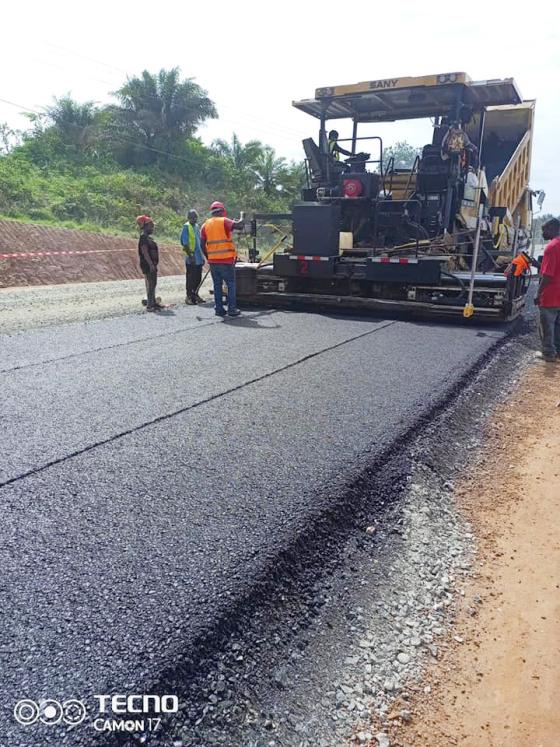Liberia: Ganta-Saclepea Road Takes A New Look

The Ganta-Saclepea highway had taken a new look after the Chinese Road Building firm ‘CICO’ began laying asphalt. In December 2020 president George Weah broke ground for the pavement of the 38 kilometers of road, beginning from central Ganta to Saclepea.
The completion of the road is expected to not just boost the economic development of rural Liberians, but will quickly connect urban to rural areas and significantly reduce travel time and increase vehicular movement along those routes, improving ease of access to markets, educational institutions, hospitals, and other social services for economic growth and development.
For example, the construction of the Monrovia -Ganta highway during the administration of former President Ellen Johnson Sirleaf led to rapid improvement in the infrastructural development of Ganta. The road paved the way for the construction of new and improved hotels, shopping and entertainment centers.
Trade and commerce greatly improved, owing to the new road. As a result of the conducive business environment, Ganta is booming, attracting people from Monrovia to hold retreats, seminars, and other activities — enhancing the commercial hub to be known as ‘the city that never sleeps. Ganta is a transit point for those traveling to and from southeastern Liberia, Ivory Coast, and Guinea. Commuters depend largely on Ganta for food, accommodation, and entertainment.
The Ganta-Saclepea highway construction is the first ‘lot’ of the 118-kilometer road from Ganta to Zwedru – benefiting major urban areas like Saclapea and Tappita in Nimba County — the country’s second most populated county.
Phase one comprises the asphalt pavement of the road from Ganta to Tappita, while phase two starts from Tappita to Zwedru (125km). The construction cost of the 39 kilometers from Ganta-to-Saclapea road, which includes upgrading seven bridges, amounts to US$30.3 million and the width of the road is 10.5 meters.
For decades, the Ganta to Zwedru road corridor has been in a deplorable state and it gets worse during the rainy season, impeding the movement of people, goods, and services.
In a 2018 report on Liberia, the World Bank noted the country’s road network reaches approximately 73 percent of the total population and that road quality has long been a matter of concern.
The report, which is titled, Spatial Analysis of Liberia's Transport Connectivity and Potential Growth, says nearly 60 percent of Liberia’s unpaved roads remain in poor or very poor condition; while the secondary and tertiary road networks, which constitute last-mile connectivity in rural areas, appear in particularly poor condition.
It added that the 2016 Rural Access Index (RAI) reveals 1.6 million rural people in Liberia with access to a road network in good condition, leaving 2.3 million people unconnected to the road network; poverty remains persistently high where rural accessibility is low. Also, the World Bank report added that rural accessibility of 41.9 percent leaves 2.3 million rural people unconnected to a good road network and constitutes a significant constraint; limited inland road connectivity contributes to the scarcity of regional trade across inland borders.
The new development on the Ganta-Saclepea highway, which has been deplorable for years, has brought delight to the citizens, especially those plying the route on a daily basis. With the commencement of the laying of asphalt, dozens were seen jubilating for the improvement of the road, describing it as a step toward alleviating poverty.
“We have suffered too much on this road, every year the road becomes deplorable and sometimes completely cut off but, with this pavement, it surely improves the economic and social development along the highway and even beyond,” said an elderly lady.
CICO had begun the laying of asphalt from Saclepea highway toward the center of town, where the company has been constructing drainages and sidewalks. The company has also constructed most of the critical bridges along the highway and also reinforcing Yarsonnon Bridge, which is one of the longest bridges along the road.
In the same development, China Railway had also begun laying the asphalt along Sanniquellie-Loguatuo Road in the Northeast of Nimba. The road is one of the busiest economic routes in Nimba and Liberia at large. At the same time, the Sanniquellie-Loguatuo road is also vital because Loguatuo is one of Liberia’s major rural ports of entry.
